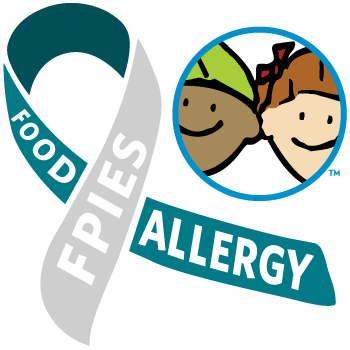What is it?
FPIES is a rare, non IgE mediated food allergy. It’s a T-cell mediated allergy that transpires in the GI tract and is often misdiagnosed or left undiagnosed for a significant period of time because it’s not widely known. I hope that by spreading the word on signs and symptoms, these rare children can get an answer more quickly and on the path to recovery!
Symptoms
Some babies with FPIES exhibit symptoms from birth. Whether they’re breastfed or formula fed, moms begin to notice excessive spitting up or vomiting, diarrhea, mucous stools, occult (invisible) or visible blood in stools, failure to gain weight or grow, eczema, significant gas pains, trouble sleeping, colic, relentless crying, and lethargy. Many infants will have one of these symptoms, some will have multiple symptoms. Reacting to a mother’s breastmilk was nearly unheard of in the medical community when Jett began reacting to my milk. Doctors had said that babies could react to dairy or soy through my milk, but not to anything else.
I’m so thankful I didn’t listen to them and sought to figure out the additional trigger foods in my diet! As the knowledge base grows, doctors are slowly giving more accurate information, although, it’s still widely misunderstood. Formula fed infants typically have more severe reactions as they’re receiving the food proteins directly, not filtered through their mother’s milk. While an acute reaction through breastmilk isn’t unheard of, it is less common.
The more common emergence of FPIES is after the introduction of solid food. Parents are frequently brushed off and told their child has a stomach bug, is just getting used to processing solid foods, or symptoms like mucous stools, gas, and colic are normal. If you’re concerned about FPIES, food allergies, or food intolerances please ask for a referral to a gastroenterologist or an allergist. It’s important to find a doctor who is very educated on FPIES or you could deal with having these symptoms ignored a second or third.. or even fourth time. There’s a Locate a Healthcare Provider feature on the FPIES Foundation website. This is a good place to start.
There are two types of symptoms; chronic and acute.
Chronic FPIES symptoms include:
Poor weight gain or weight loss
- Failure to thrive
- Chronic diarrhea
- Mucous stools
- Blood in stools (either visible or occult)
- Bloating and gas
- Trouble sleeping, waking in pain
- Reflux
- Rashes
Acute FPIES symptoms include:
- Repetitive vomiting typically starting within an hour or two of ingestion
- Diarrhea to dehydration
- Dehydration caused by constant vomiting and/or diarrhea
- Lethargy
- Shock
- Low blood pressure and/or body temperature
Acute reactions often require immediate attention. The typical course of action is administering Zofran to stop the vomiting and an IV for hydration.
Diagnosing FPIES
There are no tests for FPIES and it’s usually a diagnosis of exclusion. Allergists will typically do either blood testing or skin prick testing to rule out IgE mediated food allergies. Some doctors use patch testing, but the results aren’t very reliable and this is not considered an adequate test for finding safe or reactive foods. The only way to “test” a food is an oral challenge or a “food challenge”. Your child’s team of doctors can help guide you in trails, choosing foods, and forming a nutritionally complete diet.
Trigger Foods
The most common trigger foods are dairy, soy, rice, and oats but any food can be a trigger. Poultry, squash, banana, sweet potato, and avocado are also common trigger foods. We use this very helpful survey to help us choose “low reaction” foods for our food trials. Food trails should be conducted when your child is exhibiting no symptoms (known as baseline). There is a greater chance your kiddo will react to a new food when they’re in a state of reaction. It also gives you a clear delineation between your child’s normal sleep and stooling schedule, appetite, and skin appearance so you can note any changes. FPIES kids can take multiple exposures to build an immune response and a reaction. It’s important to only trial one food at a time so you know which food is causing issues.

Prognosis
There is no cure for FPIES. Avoiding trigger foods is the best way to help your child. After complete avoidance for 18-24 months, a retrial should be done. This allows the child’s immune system to “forget” the reaction to the food proteins. Repetitive reactions can lead to malnourishment, failure to thrive, weight loss, developmental delays, and feeding aversions. It’s important to let you kiddo completely recover between food introductions.
The best news about this rare allergy is that MOST children outgrow FPIES by the age of 5. Some outgrow it even younger. Some kids end up having FPIES triggers for a lifetime. Typically its only one or two foods that last past childhood. There are cases of adult FPIES, shellfish is the most common adult trigger food, and sudden onset is typical.
If your child or someone you know exhibits these symptoms, please direct them to some FPIES resources.
Check out The FPIES Foundation HERE and the Kids with Food Allergies website HERE for more information.



